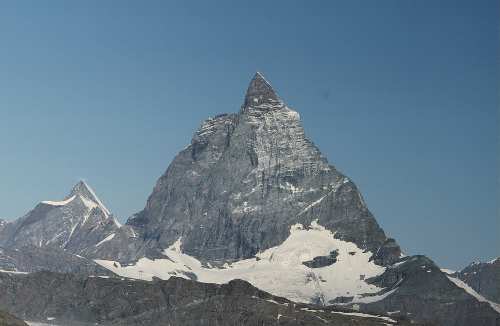Rule 3: Never underestimate the
pioneers.
Sometimes we are tempted to
think that if some mountaineer or explorer did something a hundred
years ago in hobnail boots, knee breeches and a tweed jacket,
we can automatically assume it was pretty easy, and that with
our superior modern skills, personal strength, and high-tech equipment,
we will not have any trouble repeating said accomplishment. In
fact we could likely get started after lunch and still do it before
dark. Those given to this line of thinking are likely to find
through their experience that the pioneers were actually pretty
good. As 'Exhibit A' in support of this argument I offer the following
obituary:
Albert H. MacCarthy
1876-1956
IN MEMORIAM
(From The Alpine Journal, Vol. LXI, No. 294, May 1957, page 530,
and written by Henry S. Hall, Jr.) )
Albert H. MacCarthy,
a member of the Alpine Club since 1916, who died October last,
was one of the most rugged American climbers of his day. He was
an Honorary Member of both the American Alpine Club and the Alpine
Club of Canada.
After graduation from the United States Naval Academy in 1897
he served for ten years, but resigned his commission in 1907 shortly
after his marriage. He then tried his hand at various occupations
including textiles, the law, banking, real estate, and hotel operation,
but was not entirely content in any of these. In 1910 he and his
wife went to British Columbia where they bought land in the upper
Columbia River valley near Lake Windemere and established a ranch,
only two or three years before the collapse of the boom in western
Canada.
Ranching for them resulted in no profit but great happiness. They
soon took up climbing. Mrs MacCarthy came of an athletic family
(her brother, W. A. Larned, had been six times U.S. national singles
tennis champion) and she and Mack very soon became proficient
and strong climbers. W. W. Foster, a division engineer with the
Canadian Pacific Railway, with headquarters at Revelstoke, became
a very good friend. Conrad Kain, an Austrian guide, settled near
them. The MacCarthys and Kain had the nearby Purcells almost to
themselves for a while and made first ascents of many of the highest
peaks there. In 1913 MacCarthy, Foster, and Kain made the first
ascent of Mt. Robson by a route from the north which was not repeated
for forty years. Mack made the first ascent and descent in one
day of the N.W. ridge of Mt. Sir Donald in the Selkirks, as well
as guideless ascents of several other good peaks nearby. In 1916
he and Kain made the first ascent of Mt. Louis near Banff. The
MacCarthys, both with and without Kain, climbed many peaks in
the Canadian Rockies. In the First World War, Mack returned to
active duty with the U.S. Navy.
In 1920 he, A. W. Wakefield and I made the first traverse of Mt.
Assiniboine, in sixteen hours from the A.C.C. camp near Lake Magog.
In 1923 interest began to focus on Mt. Logan (19,850 ft.) in Yukon
Territory: the highest in Canada and second only to Mt. McKinley
in North America. MacCarthy was asked to undertake leadership
of an expedition to it, organized by the Alpine Club of Canada
with strong support from the American Alpine Club. From May 1924
to July 1925 MacCarthy spent twenty-six tough weeks on the reconnaissance,
winter freighting, and actual attempt with a party of eight climbers,
resulting in success on June 23, 1925.
The next year, 1926, in his fifty-first
year, Mack went over to see the Alps. He soon decided that he
cared less for the way of life and climbing there than in our
West, but characteristically he made the most of his one season.
In sixty-three elapsed days, forty-five climbing days, he did
a hundred and one peaks and temporarily exhausted six different
guides. One of his guides said to me a year later: ‘Your
Mr. MacCarthy is a very strong man and he never wants to stop.
We guides must have some rest.’ Mack often climbed four,
five, and six days consecutively, through fair weather and foul.
He had made up his mind to do certain peaks and he did them. On
Logan the nightly temperature for three weeks averaged about -20?F.
and the wind averaged to howl twenty hours out of every twenty-four,
so Mack was not too impressed by summer storms in the Alps.
But this was his last season of real climbing, and for the next
few years he and his wife continued to enjoy life on their ranch.
In 1930 the MacCarthys sold the ranch, moved first to Colorado,
and then in 1932 to Annapolis, Maryland. There they owned and
operated Carvel Hall, the large hotel near the Naval Academy,
and devoted considerable time to the welfare of animals, which
they both loved, through the S.P.C.A. Mrs. MacCarthy died in 1944.
In his later years Mack interested himself actively in civic affairs,
Historic Annapolis, the Anne Arundel General Hospital, and the
local radio station (WNAV), and always in good work for his animal
friends.
MacCarthy was a very capable, strong climber. Whether carrying
an eighty-pound pack in the bush, or climbing an airy Alpine ridge,
he was deliberate, careful and safe, and always considerate of
the less experienced people on his rope as at the camps of the
Alpine Club of Canada. At these annual summer camps in the mountains,
he took many beginners or less experienced on their first climbs.
Those who went out with him knew they would have a good day, learn
sound climbing, and return to camp safely.. He and General Foster
continued to go to the A.C.C. camps almost to the end. It was
always an event when either of them came into camp.
Henry S. Hall, Jr.


